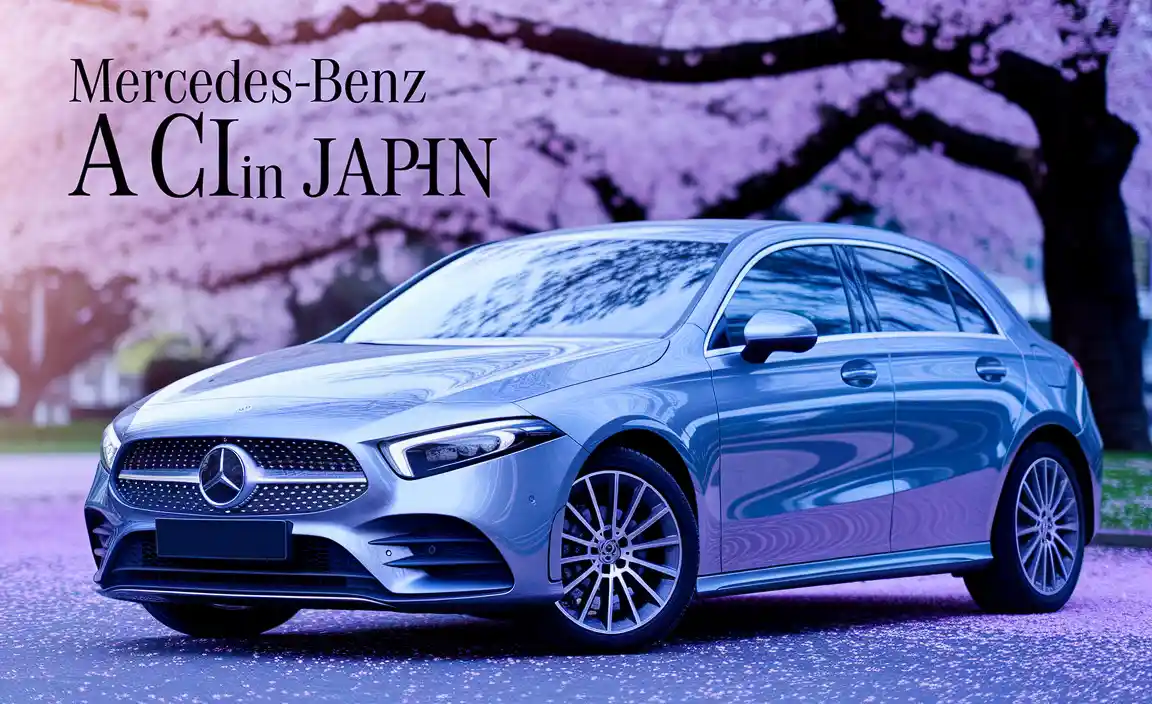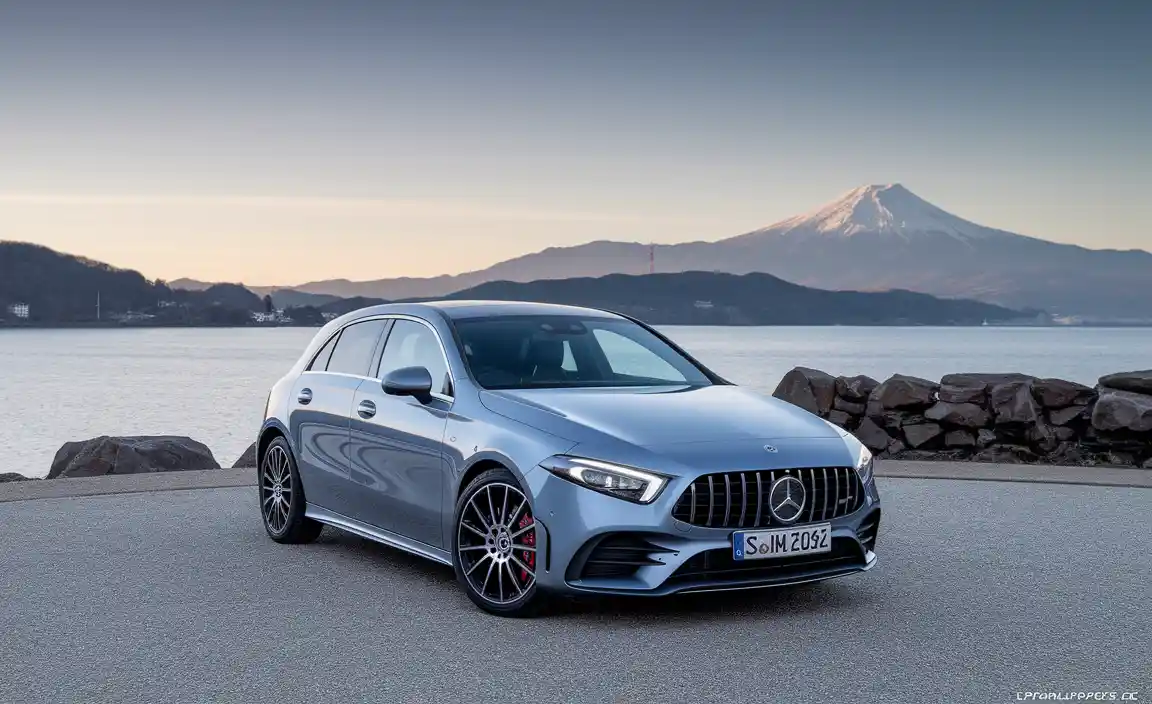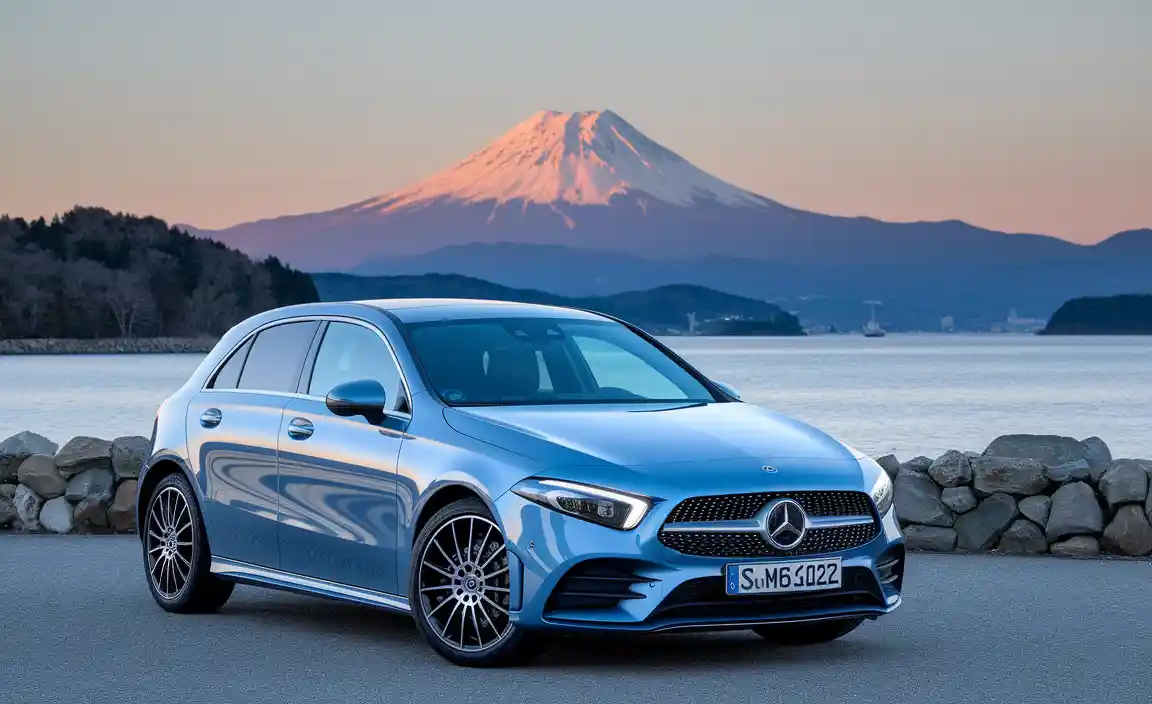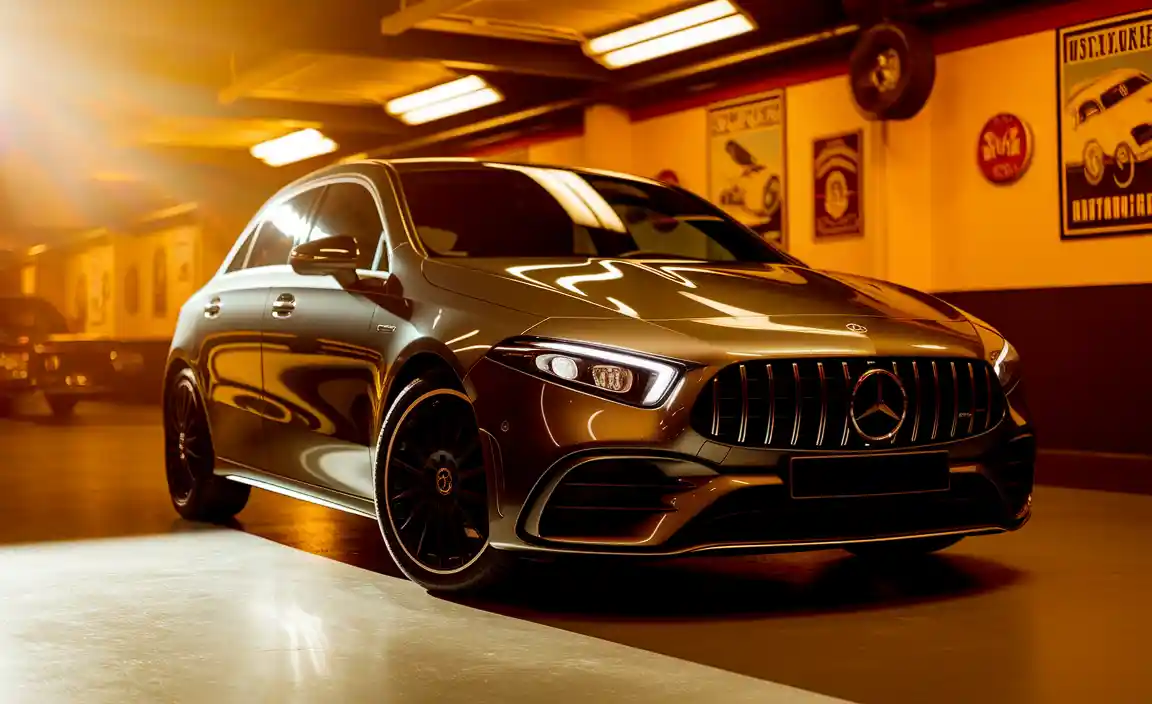Imagine cruising through Tokyo’s tight backstreets in a sleek, smart car that turns heads at every signal. That’s the Mercedes-Benz A-Class for you. In Japan—a country that values compact design, precision engineering, and subtle luxury—the A-Class fits right in.
Japan’s urban spaces are famously compact. Parking spots are tight. Roads are narrow. And people love efficient, stylish solutions. The A-Class is like it was made for this world. Its small footprint and agile handling make it perfect for city life. But don’t let the size fool you—it packs the punch and polish you’d expect from a Mercedes.

You’ll often see it zipping past on the expressway or parked neatly in upscale Tokyo neighborhoods. It’s not just a car here. It’s a statement of refined taste.
Why The A-Class Is Popular In Japan
- Premium Look, Compact Size
The Japanese love things that are beautifully designed and space-conscious. The A-Class brings both. It’s sleek, futuristic, and easy to maneuver in Japan’s crowded streets. - Advanced Tech That Feels Like Magic
Japan is known for its tech-savvy crowd. The A-Class delivers with MBUX—Mercedes’ AI-powered infotainment system. Say “Hey Mercedes” and it actually listens and responds. That’s the kind of futuristic charm Japanese drivers adore. - Efficient Yet Powerful
With rising fuel costs and strict emission standards in Japan, efficiency matters. The A-Class offers just that, without compromising the thrill of the drive. - Luxury That Feels Just Right
Japan respects quiet sophistication. The A-Class doesn’t scream for attention—it whispers elegance. Its interior feels upscale, but never over-the-top.

Built For Japanese Roads
Mercedes-Benz didn’t just bring the A-Class to Japan and call it a day. It tailored the experience. Models sold in Japan often come with right-hand drive, custom suspensions for local roads, and features that match the country’s unique driving style. That attention to detail goes a long way.
The Hybrid And EV Angle
With Japan pushing for a greener future, many wonder if the A-Class will go full electric soon. While the A-Class still leads as a compact luxury petrol option, Mercedes’ EQ line is making waves. If trends continue, we might soon see a fully electric version winning hearts across Japan too.
Evolution Of The Mercedes‑Benz A‑Class

Early Models (2013–2015)
When the Mercedes‑Benz A first arrived in Japan around 2013, it felt like something different in the compact luxury space. The hatchback-sized vehicle popped with its alloy wheels and sleek shape. On narrow city streets, it looked polished and elegant. I still recall spotting one parked in front of a cafe near Shibuya. It stood out—not because it was loud, but because it felt refined.
Early buyers loved the mix of performance and quality—even though the price was high by local standards. It came as a fully imported model and required marine insurance when shipped to ports like Yokohama. Many who invested in it saw it as a life upgrade—small on the outside, yet shaped by German engineering and Japanese attention to detail.
Mid‑Generation Updates (2016–2019)
The 2016 facelift brought nicer tech and subtle styling tweaks. The design stayed smooth, but Mercedes enhanced the interior with better materials and improved torque from a revised four-cylinder engine. Tech features like Android Auto started popping up, and the pre-ship inspection protocols got tighter. Dealers were good about assuring customers the units were clean and in great condition.
I met a friend who imported a used 2017 A‑Class. He got it at a reasonable price, shipped with trusted shipping agents, and still had a nearly new feel. He raved about the import process—they checked the unit carefully and even handled marine insurance for safe delivery.
Recent Models (2020–2024)
From 2020, the A‑Class in Japan took a leap forward. The latest arrival models came with hybrid powertrains. The cherry-red A250 AMG Line variant was the talk of Tokyo. With AMG styling and sharp tech, it felt like a performance statement wrapped in everyday grace.
By 2024, Mercedes was also pushing hybrid models with hybrid traction battery systems. That brought solid fuel economy without sacrificing performance. Prices moved up, but the premium felt earned. Owners enjoy a small, yet luxurious unit that balances city life with weekend drives.
Features Of The Mercedes‑Benz A‑Class

Exterior Design And Aesthetics
The A‑Class turns heads with a clean, flowing form. The alloy wheels give it a sporty touch, and the refined presence is unmistakable. In Japan, where many compact cars look the same, this one stands out. It blends everyday utility with luxury cues. Metallic finishes like graphite gray metallic and selenite gray add class without shouting.
If you walk up to one, you’ll notice how the design feels intentional. The headlamps have sharp patterns. The grille edges are crisp. From afar, you sense motion even when it’s parked. That’s the magic of Mercedes.
Interior Comfort And Technology
Step inside, and you enter a cocoon of refinement. The dash curves gently, while interior trim—like nappa leather or optional two-tone panels—enhances the ambiance. The car is built around the driver, but it still treats passengers right. In fact, rear passengers enjoy space that surprises for a compact.
Front seats are soft yet supportive. The steering wheel is wrapped in leather and rests comfortably in your hands. Controls feel tactile. The ambient lighting adds subtle luxury during night drives. And the digital instrument cluster is bright, clear, and intuitive.
You get Android Auto, a clean MBUX-based interface, a crisp digital display, and voice commands. On short trips or long drives, you have full connectivity and comfort.
Performance And Engine Options
The A‑Class offers a few engine choices in Japan. The A250 AMG Line heats things up with a turbocharged 2.0-liter engine. It delivers strong horsepower and solid torque. Gentler engines are available too, pairing decent punch with better fuel economy.
I once drove an A250 down the Tomei Expressway. The power was smooth and constant. The engine pulled without jerks. And when I slowed, the ride didn’t feel harsh. It balanced performance with refinement. Perfect for quick sprints or relaxed cruising.
Drivetrain Options And Variants
2WD Vs. 4WD: What To Consider
You can pick either 2WD or 4WD (4MATIC) versions. For city-dwelling folk, 2WD usually fits the bill. It keeps things light and efficient. But if you live somewhere with snow or ice—like Hokkaido—4MATIC is a smart extra. It adds grip and stability when roads get tricky.
Most drivers on honshu islands go with 2WD. Folks in cold regions—Yamagata, Nagano—go for 4MATIC. Mercedes tuned the all-wheel drive for local conditions too. It feels balanced whether it’s dry or snowy.
Popular Models: A35 4MATIC And A250 AMG Line
The A35 4MATIC brings true AMG spirit to the table. It’s sporty, sharp, and takes corners with confidence. I remember taking one through the winding roads near Mt. Fuji. It felt tight, planted, and thrilling.
The A250 AMG Line gives great style cues—red stitching, sporty bumpers—without being over-the-top. It’s very Japanese in its subtlety. It says performance and taste, without screaming. That mix makes it a hit with those who want a driver’s car with quiet elegance.
The Appeal Of The A‑Class In Japan

Market Demand And Trends
Japan loves smart, compact cars. The A‑Class fits that niche perfectly—it’s small around town but packs a premium punch. Buyers want reliability, value, and a bit of luxury. The A‑Class checks all those boxes.
I know a local business owner who chose the A‑Class over Japanese brand rivals. He liked how it reflects his style. He also pointed out how Mercedes cars have a lasting presence. Each time he picks it up, he says he feels good behind the wheel.
Price Range And Value For Investment
New models are not cheap. But customers feel they get value for their yen. If you buy a well-kept used unit—imported or certified—you can save money while enjoying German-grade quality. The value holds up well, too. Mercedes builds reputation and resale strength.
Used A‑Class units that are a few years old still hold thousands of dollars in value. Good condition and low mileage make them valuable examples. Often they sell fast once listed.
Buying A Mercedes‑Benz A‑Class In Japan
New Vs. Used: Pros And Cons
Buying new means full warranty, freshest production standards, and the peace of mind that comes with a spotless unit. You get latest arrival features, fresh paint, and updated tech.
Buying used—even imported—can cost less. But you must check the condition, mileage, and service history. If relying on shipping agents, make sure they complete a pre-ship inspection. That way, you know the unit is reliable and damage-free.
Trusted Dealers And Sources
Seek trusted dealers in cities like Tokyo and Osaka. They often offer full service and transparent history reports. If going for japanese imports, confirm shipping, marine insurance, and local registration. Use recommended shipping agents to handle customs and delivery.
Ask your dealer about color options—like graphite gray metallic, selenite gray metallic, rubellite red metallic, or even verde silver metallic. That touch makes it personal.
Global Presence And Influence
Popularity Beyond Japan: Ireland To Jamaica
The A‑Class has fans worldwide. In Ireland, folks love its handling in rain; in Jamaica, its compact ease in city traffic. In Japan, its whisper-quiet engines and refined design win hearts.
When you drive one, you join a global club. That global presence boosts its allure back home. People see you and know Mercedes delivered a world-class unit.
How International Appeal Enhances Brand Value
Every time someone in the United States sees the same model in Tokyo, that shows strength. It adds prestige to the Mercedes Benz name. It says Japanese A‑Class owners aren’t just driving a car—they’re part of a global story.
That reflection makes the car more than a unit—it becomes a statement. It lets buyers say: “This is the real deal.”
Evolution Recap: Why It Matters
2013–15 models brought the name and promise.
2016–19 models improved on tech and design at better price points.
2020–24 units introduced hybrid tech, sharper looks, and refined interiors.
Each update reflects Mercedes’ care for Japan’s market. It shows how they listen and improve. That’s rare, even for luxury brands.
Cultural Notes: Why Japan Loves The A‑Class
- The compact size fits tight streets and small parking.
- Quiet comfort suits long commutes.
- High build quality matches grooming standards.
- Subtle style blends with minimalist fashion sense.
- Performance models provide a fun escape in weekends.
Even the exterior color options speak to taste—graphite gray, rubellite red, emerald green, and patagonia red metallic make a statement. Meanwhile, interior touches like leather-wrapped steering wheel, ambient lighting, and detail-driven trim keep it classy.
Buying Guide For Japanese Buyers
- Decide between new or used.
- For used imports, ensure a clean pre-ship inspection.
- Choose a trusted dealer or shipping agent.
- Compare color and variant costs—reasonable price matters.
- Consider drivetrain—2WD for city, 4MATIC for snow.
- Test drive models like A250 AMG Line or A35 4MATIC to feel difference.
- Ask about marine insurance if importing.
- Double‑check service history and condition.
Final Thoughts
In Japan, where tradition and tech live side by side, the Mercedes-Benz A-Class hits a sweet spot. It’s elegant but practical, modern but respectful of space and purpose. Whether weaving through Shibuya or parked outside a Kyoto café, the A-Class stands out by fitting in perfectly.
FAQs
1. The Mercedes-Benz A‑Class In Japan Is Available In Which Body Styles?
In Japan, the A‑Class is offered as both a five-door hatchback and a four‑door sedan, including a long-wheelbase version in certain trims.
2. The Mercedes-Benz A‑Class In Japan Has Right-Hand Drive?
Yes, all A‑Class models sold in Japan come equipped with right-hand drive, tailored for local driving standards.
3. The Mercedes-Benz A‑Class In Japan Has What Kind Of Infotainment System?
It features the MBUX infotainment system with voice control via “Hey Mercedes,” touchscreen display, and optional augmented-reality navigation—ideal for tech-savvy Japanese drivers.
4. The Mercedes-Benz A‑Class In Japan Uses What Engines?
Japanese A‑Class versions come with various petrol and diesel turbocharged engines, including 1.3L and 2.0L petrol units, plus mild-hybrid and plug-in hybrid options in later models.
5. The Mercedes-Benz A‑Class In Japan Is Considered Compact?
Yes, the A‑Class is classified as a subcompact executive car, making it perfect for navigating Japan’s narrow urban streets.
6. The Mercedes-Benz A‑Class In Japan Has Good Fuel Efficiency?
Absolutely—many models achieve around 5 L/100 km (47 mpg), meeting Japan’s demand for fuel-efficient, urban-friendly vehicles.
7. The Mercedes-Benz A‑Class In Japan Is Sold Since When?
The third-generation A‑Class launched in Japan in January 2013, and the fourth generation hit Japanese showrooms from 2018 onward.
8. The Mercedes-Benz A‑Class In Japan Meets Local Size Regulations?
Most models exceed the 1,700 mm width threshold, so they are taxed as regular passenger cars, not kei or compact classes.
9. The Mercedes-Benz A‑Class In Japan Has Special Editions?
Yes—there was a “Final Edition” A 180 right-hand drive model released in May 2012, tailored specifically for the Japanese market.
10. The Mercedes-Benz A‑Class In Japan Offers Hybrid Versions?
Indeed, later models include mild-hybrid variants and the A 250 e plug-in hybrid, reflecting growing demand for electrified options in Japan.